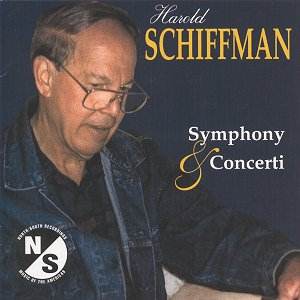Harold Schiffman, born in 1928, studied with Roger
Sessions, privately as well as at the University of California and later
at Princeton. He has composed a sizeable body of works in almost every
genre, and some of these are available in commercial recordings including
several NORTH/SOUTH RECORDINGS.
Schiffman’s Symphony (1961) is the earliest
work recorded here. It is cast in four movements with the Scherzo placed
third. The opening Allegro appassionato, basically in sonata
form, opens boldly and later alternates slower moments and restatements
of the opening theme serving as a motto throughout the movement. The
following Adagietto grazioso, the slow movement, is more intimate
in character and more lightly scored. The Scherzo that follows is lighter
in mood, "with rather a burlesque quality". The last movement
opens with a broad Largamente introduction leading into the main
body of the movement, a "march-like theme and variations".
The Concerto for Piano and Orchestra
(1982) was written for the present soloist who gave the first performance
and went on to record some of Schiffman’s piano music for N/S RECORDINGS.
It is cast in one single movement with clearly characterised sections,
and most of the music is developed from the basic material stated in
the opening section. A more animated section leads into a brisk Scherzo
fading into a short Adagio section in turn leading into the final
section Allegro vivo. A brief cadenza recalling some earlier
material is capped by a lively coda.
The Concerto for Oboe d’amore (1988)
is the last part of a triptych of works written for members of the oboe
family. It was preceded by the Oboe Concertino (1977)
and the Chamber Concerto for Cor anglais, Harp, Strings and Winds
(1986). The Oboe d’amore Concerto, as a
whole, is somewhat lighter in mood and predominantly lyrical with beautifully
singing tunes exploiting the full range of the instrument’s possibilities.
Schiffman’s music partakes of what may be best referred
to as '20th Century mainstream'. It is traditionally conceived,
often lyrical, sometimes rugged and mildly dissonant, but it communicates
directly, without excessive fuss. Schiffman has a remarkable orchestral
and instrumental flair, the latter particularly in evidence in the beautiful
Oboe d’amore Concerto.
These fine works are well served by the performers
who play with dash and conviction though this music must have been quite
new for the Hungarian players. It is given a bright recorded sound (maybe
too bright for some tastes).
If you like American symphonism as embodied by, say,
Walter Piston, Paul Creston or Peter Mennin, you will have no difficulty
whatsoever with Schiffman’s music. It does not pale in their company.
Well worth investigating.
Hubert Culot


